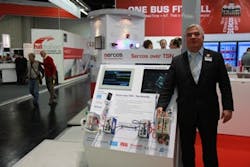Sercos, Ethernet TSN and the basis for Generation 3 of fieldbuses
I just read your interesting article on Ethernet vs. fieldbus in Control Design. Unfortunately, information about Sercos and its positioning to OPC UA and time-sensitive networking (TSN) was not mentioned.
Dipl.-Ing. Peter Lutz, managing director of Sercos International, says TSN will support real-time communication at higher speeds and lower costs.
First, let me address the major differentiators between device/fieldbus networks and Ethernet networks. So far, we can distinguish two generations of fieldbus networks. The fieldbuses of Generation 1 were based on different physical and data link layers (not Ethernet) and designed for dedicated purposes, such as drive communication (Sercos), I/O communication (Profibus, Interbus, DeviceNet) or safety communication (for example, Safetybus-p). This led to the situation that within a manufacturing unit, or between manufacturing units, different buses were required to meet the application requirements, such as a combination of Sercos + Profibus, or Sercos + DeviceNet. Ethernet was not used at all at the field level, but only when connecting machines via the machine controls to the superior IT systems (MES/ERP/SCADA). The disadvantages were not only the large number of heterogeneous and incompatible interfaces, but also the high total cost of ownership—different tools for engineering, monitoring and diagnosis, high overall complexity.
ALSO READ: Ethernet vs. fieldbus: the right network for the right application
The fieldbuses of Generation 2, developed in the early 2000s, were based on Ethernet and could be used, because of the high bandwidth of > 100 Mbit/s, for universal purposes (motion + safety + I/O over one bus). Ethernet-based networks were supporting higher speeds, but due to the non-determinism of Ethernet, different variants of real-time Ethernet were created as successor technologies of fieldbus technologies of Generation1 (Sercos III for Sercos I/II; Profinet for Profibus; Ethernet/IP for DeviceNet). Also, new protocols were created by automation companies. For exmple, B&R created PowerLink, and Beckhoff created EtherCAT. To reach a high performance—short run times, short cycle times, high protocol efficiency, sub-microsecond synchronicity—special hardware is needed for Profinet IRT, Sercos III and EtherCAT. The disadvantages of Generation 2 fieldbuses are that these RTE technologies are not interoperable, and most RTE do not even support multiple protocols to co-exist in one network infrastructure. Because of this, the networks for IT and automation are still separate and many RTE technologies need the network exclusively for real-time traffic—no protocol coexistence.
Ethernet TSN now will be the basis for the next-generation fieldbuses—Generation 3. This is an exciting milestone because for the first time, after 43 years, Ethernet by itself becomes deterministic. As no modified hardware is required to achieve network determinism, TSN will support and enable the convergence of IT and OT networks. Because TSN allows different Ethernet protocols to co-exist and share the network infrastructure—no gateways, only switches are needed. Thus, a consistent and transparent access from sensor to cloud and vice versa becomes possible. TSN not only will support real-time communication but also higher-speeds and lower costs because of the cross-industry support of the TSN technology from automotive, multimedia, automation.
Sercos has been using time-triggered and time-slot-based communication since the introduction of the Sercos technology in the late 1990s in order to meet the requirements for high-speed real-time communication for all kinds of production machines and demanding automation applications. Sercos I/II was mainly used for drive communication. Ethernet-based Sercos III became a universal automation bus supporting motion, safety, I/O, vision, TCP/IP and other Ethernet protocols over one single network. In the future, Sercos will rely on deterministic Ethernet (Ethernet TSN), which will lead to significant advantages, including standardized hardware, lower cost, higher speeds and IT connectivity, for the users of the technology.
At the same time, Sercos supports the requirements of Industry 4.0/ IoT, regarding semantic interoperability, For this, a standardized OPC UA Sercos information model was defined that brings together the well-defined device profiles of Sercos (semantic for drives, I/Os, encoders, energy) with the information model and data exchange standard of OPC UA. With this approach, the functions and data of Sercos devices are made available and accessible via OPC UA.
Use cases cover a broad range from device parameterization and network configuration up to energy management and preventive maintenance. The mapping rules specified by Sercos can be used for different implementation approaches. On the one hand, the OPC UA server functionality can be implemented in a Sercos master device—for example, CNC or PLC. On the other hand, it is possible to implement this functionality in a Sercos slave device. In the latter case, the OPC UA accesses are executed in parallel to the Sercos real-time communication or even without any Sercos real-time communication.
About the Author
Peter Lutz
Peter Lutz

Leaders relevant to this article:


